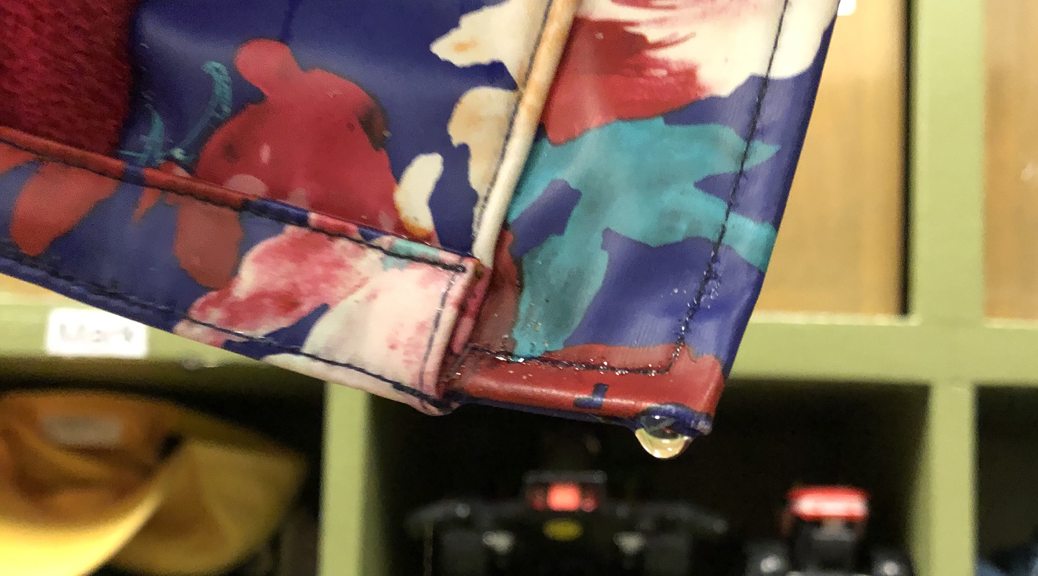Nicole Land thinking with Alicja Frankowski, Andrea Thomas, Selena Ha, and Maria Wysocki
We are curious to think with how we move with documenting – how do we keep our pedagogical documentation in motion, as a process entangled with our everyday movements with the playground? We printed and laminated some images of the children jumping with the logs. As we brought the laminated images into the sand, there were a few children who became concerned with keeping the documentation “clean”. They seemed interested in preserving the documentation as intact images, uncovered by sand or by a presumed, predictable idea of what the sand might do to the images. This makes me very curious to think more about the relations with documenting that we hold and participate in: in the name of what do we want to “preserve” documentation? What inheritances and existing conditions in the field invite relations with documenting concerned with preserving or keeping documenting intact? How? Why? What relations with documenting might we be interested in cultivating? What ways of being with documenting align with our pedagogical commitments?
Extending on this idea of keeping documentation “clean”, I want to be curious how “cleanliness” happens and matters. On this particular morning, there were many moments that refused taken-for-granted ideas of cleanliness but also that make me want to think carefully about our relations with sand and rain and what these materials do beyond dirtying or soaking (which we might, in a status-quo way, understand sand’s dirtying and rain’s soaking as not “clean” or orderly or controlled things). As the documentation travelled into the sand, some pieces became covered in sand, and there was a moment of a few children trying to “clean” the documentation off using other documentation. The damp sand clung to the laminated surface of the documentation differently than it might have to only a paper, and refused to brush off easily – the wet lamination, which in some sense “protects” the documentation, also held on to wet sand pieces, refusing to maintain a sort of “cleanliness” of the documentation, even when children tried to use sheets of documentation to brush off the documentation buried in the sand. Here’s a gif that lingers with this moment:
This makes me want to think how we might understand this moment within a question of the relations we create with documentation: why does it matter that there was a push to “clean” the documentation? And, even more interestingly, what happens when we think of what happens with sand and documentation by attending to what sand and laminated images do together: how does the refusal of sand to clean nicely off the documentation materially, physically, intervene in our inherited relations with documentation that make us want to preserve and showcase intact, perfect documentation? I think it is fascinating to pay careful attention to how sand resolutely refuses to follow children’s intentions to clean the documentation – why does this matter? How does this call us to reimagine our existing practices of documenting with sand and images in the sand area (and with rain on drizzly days)?
I want to suggest that this idea of “clean” and moving entangled too with other moments in the morning. When we were exploring chalk on bodies and drawing with chalk on faces earlier in the morning, we were thinking with how chalk highlights the imperfections and nicks on our skin, and how sand travels from our oily palm skin onto the ground and fabric in messy, powdery ways. Chalk refuses to be clean (orderly, predictable, contained) in how it moves. Cleanliness (as practices toward order and containment) then returned differently, I think, as the rain picked up. Bare feet and socks and jackets and hair got really, really wet, especially as children gathered under the area of the tarp that collected and dripped rain water in a super interesting heavy stream. I want to be curious here how we can think of rain as intervening in ideas of cleanliness – how do wet barefeet and drenched jackets unsettle how and why we want to maintain “cleanliness”? How do moments like these make visible what it is we might ignore or shut down sometimes in the name of preserving clean, and are these practices that we want to stand behind (and why)? Cleanliness also mattered with sand as the rain picked back, as children noticed how the collected pockets of rain by the stairs and under the tarp could be used to “clean” the sand off their feet. This gets even more tangled and complex, as there’s this unruly (monstrous, maybe) rain and uncontainable, un-cleanable sand that come together with barefeet (a practice that we might consider to not be “clean”, where clean means a particular way of keeping bodies tidy and separate from messy materials) to really, really complexify what we mean and do we when we talk about “clean” – messy rain and messy sand (the same sand that messes with keeping documentation clean) come together to create conditions to make less-sandy but still messy feet. There’s almost this layering of messy in this ongoing refusal of seeking purity or containment. I want to suggest that clean and messy become questions of relations and practices: how do we come to understand what it means to be clean or dirty in any one movement/moment? With what intentions do we seek cleanliness? Or messiness? What happens when materials or weather interfere in our taken-for-granted relations with cleanliness and documenting and moving? How do we respond? Why?
